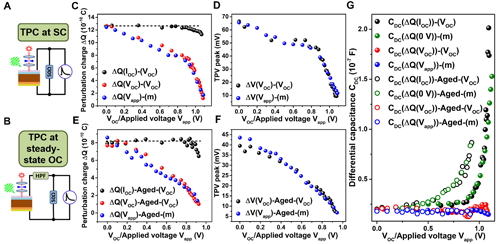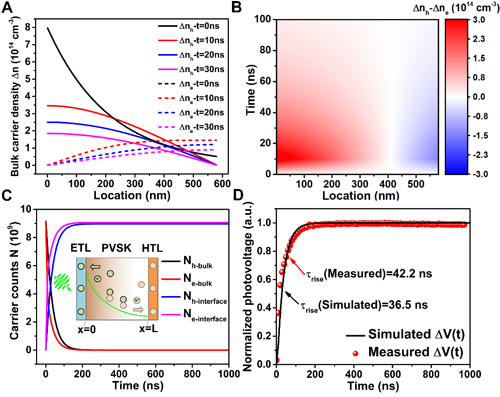Electrical Transients Quantify Charge Loss in Solar Cells
Date:12-03-2020 Print
Solar cells are photovoltaic devices that convert light to electricity. During the photoelectric conversion process, a photovoltaic device internally undergoes multiple charge-carrier dynamics processes. Such as, charge generation, charge transfer and transport within the bulk absorber and the charge transporting layers, charge recombination at the bulk and interface, and even photoelectric hysteresis. These internal charge-carrier processes intrinsically dominate the performance of a photovoltaic device itself. So, here come the questions. How to accurately measure these charge-carrier dynamics parameters? How to accurately understand the physical mechanism of these dynamic processes? It is an important research topic in the fields of photo-electrics and electro-optics. It is also a significant approach to evaluate material performance and guide device structure optimization to improve performance of photovoltaic devices.
Prof. MENG Qingbo's group from Institute of Physics, Chinese Academy of Sciences has been devoting to the development of quantitative measurement and analysis methods of physics properties such as charge dynamics and defect states of solar cells while exploring new high-performance thin-film solar cells, and has achieved a series of research results. For instance, a modulated transient photoelectric measurement system has been successfully developed, which has realized the measurement of the charge dynamics of solar cells under actual operating conditions (Rev. Sci. Instrum. 2016, 87, 123107). The measurement of ion dynamics for perovskite solar cells has also been achieved (Appl. Phys. Lett. 2015, 107, 163901). Quantitative analysis of the interface and bulk defect distribution of solar cells has been studied and the origin of the electrical stability of perovskite solar cells has also been elucidated (Adv. Energy Mater. 2019, 9, 1901352).
Recently, MENG's group focus on the differential capacitance of photovoltaic devices to discuss the validity of conventional tail state framework based on electrical transient technologies. They point out that conventional tail state model has certain unreasonable assumptions on the consistency of the measurement state of the devices and the physics process for the establishment of transient photovoltage. Furthermore, they prove this conventional tail state framework based on the electrical transient technologies is not universal and rational in the fields of measurement and research for solar cells.
After simulating carrier dynamics and charge loss mechanism behind electrical transients through theoretical calculation, they propose a new analysis methodology to quantitatively extract charge dynamics properties and charge loss mechanism of photovoltaic devices (such as charge extraction and collection quantum efficiency and the density of defects within the absorber) from the electrical transient technologies. This methodology is universal to study conventional silicon, emerging kesterite and perovskite solar cells herein and is able to extend to other similar photovoltaic device systems. This work provides an alluring route for a comprehensive investigation of dynamic physics processes and charge loss mechanism of solar cells and possesses potential applications for other photoelectric devices.
This study entitled "Exploiting Electrical Transients to Quantify Charge Loss in Solar Cells" was published on Joule (10.1016/j.joule.2019.12.016). LI Yiming, Ph.D. student from the Institute of Physics and SHI Jiangjian, associate professor from the Institute of Physics, are co-first authors. Prof. MENG Qingbo from the Institute of Physics is the corresponding author.
The study was supported by the National Science Foundation of China, the International Partnership Program of Chinese Academy of Sciences and the National Key R&D Program of China.
 |
| Fig.1 Accurate measurement of theCDC. (Image by Institute of Physics) |
 |
| Fig.2 Simulation of the charge transport within the perovskite absorber and the establishing process of the photovoltage. (Image by Institute of Physics) |
 |
| Fig.3 Electrical transients study of perovskite solar cells, such as charge extraction and collection quantum efficiency (B) and the density of defects within the absorber (C). (Image by Institute of Physics) |
Contact:
Institute of Physics
MENG Qingbo
Email:qbmeng@iphy.ac.cn
Key word:
solar cell; electrical transients; charge loss; quantum efficiency; defect;
Abstract:
Electrical transients enabled by an optical excitation and an electric detection provide a distinctive opportunity to study charge transport, recombination and even photoelectric hysteresis of a solar cell in a wide time window ranging from nanoseconds to seconds. However, controversies on how to exploit these investigations to unravel the charge loss mechanism of the cell have been ongoing. Herein, a new methodology of quantifying the charge loss within the bulk absorber or at the interfaces and the defect properties of solar cells has been proposed. This methodology has been successfully applied in the study of commercialized silicon and emerging Cu2ZnSn(S, Se)4 and perovskite solar cells herein and should also be applicable to other similar photovoltaic device systems. Overall, this work provides an alluring route for a comprehensive investigation of dynamic physics processes and charge loss mechanism of solar cells and possesses potential applications for other optoelectronic devices.


